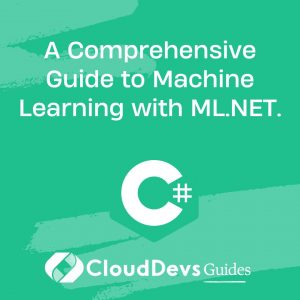A Comprehensive Guide to Machine Learning with ML.NET.
Table of Contents
The world of machine learning (ML) has evolved substantially over the past decade, and alongside this evolution, we have observed a plethora of tools and frameworks emerge. Among them is ML.NET, a cross-platform, open-source machine learning framework from Microsoft, designed for .NET developers. As businesses increasingly look to hire C# developers with ML expertise, understanding ML.NET becomes even more critical. In this blog post, we will take a closer look at ML.NET and walk through some examples to demonstrate its power and flexibility.

Table of Contents
1. Introduction to ML.NET
ML.NET offers .NET developers an opportunity to integrate custom ML into their apps without requiring expertise in the domain. Since it works with C#, F#, and other .NET languages, developers can stay within their comfort zone, avoiding the need to switch to Python or R for ML purposes.
Some of the key features of ML.NET include:
– Ease of use: With its intuitive API, developers can build and train custom machine learning models using C# or F# without any prior expertise.
– Built-in algorithms: ML.NET comes with a rich set of built-in algorithms for tasks such as classification, regression, clustering, and more.
– Cross-platform: It runs on Windows, Linux, and macOS, ensuring flexibility across various environments.
Let’s delve deeper by exploring some examples.
Example 1: Binary Classification
Suppose you have a dataset of customer feedback, and you want to determine whether the feedback is positive or negative. This is a classic binary classification problem.
Step 1: Define your data classes
```csharp
public class FeedbackData
{
public string FeedbackText { get; set; }
public bool IsPositive { get; set; }
}
public class Prediction
{
public bool PredictedLabel;
}
```
Step 2: Load your data
```csharp
var context = new MLContext();
IDataView dataView = context.Data.LoadFromTextFile<FeedbackData>("./data/feedback.csv", hasHeader: true);
```
Step 3: Build and train the model
```csharp
var pipeline = context.Transforms.Text.FeaturizeText("Features", "FeedbackText")
.Append(context.BinaryClassification.Trainers.SdcaLogisticRegression());
var model = pipeline.Fit(dataView);
```
Step 4: Evaluate and use the model
```csharp
var prediction = model.CreatePredictionEngine<FeedbackData, Prediction>(context).Predict(new FeedbackData
{
FeedbackText = "This product is great!"
});
Console.WriteLine($"Is Positive? {prediction.PredictedLabel}");
```
Example 2: Regression
Imagine you’re working with a dataset of house prices, and you want to predict the price of a house based on its features.
Step 1: Define your data classes
```csharp
public class HouseData
{
public float Size { get; set; }
public float Price { get; set; }
}
public class Prediction
{
public float PredictedPrice;
}
```
Step 2: Load your data
```csharp
var context = new MLContext();
IDataView dataView = context.Data.LoadFromTextFile<HouseData>("./data/houseprices.csv", hasHeader: true);
```
Step 3: Build and train the model
```csharp
var pipeline = context.Transforms.Concatenate("Features", new[] { "Size" })
.Append(context.Regression.Trainers.Sdca());
var model = pipeline.Fit(dataView);
```
Step 4: Evaluate and use the model
```csharp
var prediction = model.CreatePredictionEngine<HouseData, Prediction>(context).Predict(new HouseData
{
Size = 1500
});
Console.WriteLine($"Predicted Price: {prediction.PredictedPrice}");
```
Wrapping up
ML.NET is a powerful framework that brings machine learning closer to .NET developers, breaking the barrier that once existed between ML and mainstream development. The examples provided only scratch the surface; the framework offers a broad spectrum of tools for tasks such as anomaly detection, recommendation, time series forecasting, and more.
If you’re a .NET developer aiming to integrate machine learning capabilities into your applications or looking to hire C# developers with expertise in ML, ML.NET provides a convenient and efficient way without the steep learning curve often associated with other ML frameworks. Give it a shot, and you might find it to be a game-changer for your projects.



